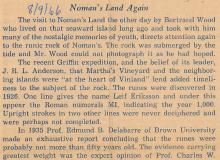The bombing of Noman’s Land has ended. Plans are underway to transfer the small island from the U.S. Defense Department to the Department of Interior. By Sept. 1, the Navy will turn the property over to the U.S. Fish and Wildlife Service, which will manage it as a wildlife sanctuary.
For more than 50 years the tiny one-square-mile island has been under the management of the military, distant and removed from the Vineyard. Often Gay Headers have watched as jets and helicopters descended on the Island in imaginary missions of war. During the Gulf War there was more activity. Years ago, a few Islanders measured the international political climate by the number of military missions to the island.
Now that South Weymouth Naval Air station is in the process of closing, Noman’s Land is being put out of service as a bombing range.
Capt. Robert A. Duetsch, commanding officer of the air station, told the Gazette yesterday that this week work crews were already on the island beginning what will be a summer-long process of removing debris. Captain Duetsch said that bombing missions to Noman’s stopped at the beginning of May. The captain said he visited the island a few weeks ago to assess cleanup priorities. “We’ve got a crew out there tomorrow [today]. Later on in the summer we will go out there and try to clean up some of the inert bombs.
“Our plan is to make the island safer than it is now without disrupting the natural habitat,” he said. For most Vineyarders there will be no change to Noman’s. It will remain restricted and off limits to visitors. It is not only a dangerous island to walk but naturalists hope to keep it off limits to visitors.
The only change that will be noticeable is that there will no longer be military aircraft strafing targets. Although the military has used only inert practice ordinances on the island for years, some Vineyarders have observed fires starting up after a bombing mission. From now on that will no longer be an issue.
“Some of the stuff we’ve used for targets will be pulled off,” the captain said. That includes tires, and an A-4 airframe. They are even considering removing the remains of Coast Guard buoys that have been strafed to pieces. How much is removed has yet to be decided. The captain said an effort will be made to remove a great deal without disturbing the natural habitat. “We know birds have lived there successfully for years. We want to make it natural for them without destroying the place.
“The restricted signs are going to stay. When we turn it over to the Fish and Wildlife Service it goes with the understanding that the property remains restricted,” the captain said.
The Fish and Wildlife Service has no plans for changing Noman’s Land present isolation. “We’ve had a joint management agreement with the Navy since 1975. There are no plans to change,” said Diana Weaver, a spokesman for the service.
She said the organization is working on a memorandum of understanding with the Navy. “There are no plans to open the island to the public. There is always the potential for injury,” she said.
The Navy took the island in 1943. In 1985, the Dukes County commissioners offered to buy Noman’s but were turned down. The Navy made the point that it liked the island as it was. At the time, Noman’s was an important bombing site.
A great deal has changed since that argument was used. The military has been downsized. The South Weymouth Naval Station is scheduled to close by the end of 1997. Captain Duetsch said: “The 104th fighter wing of the Massachusetts Air National Guard in Barnstable used it as frequently if not more than anyone else.”
Advances in training pilots with computers and electronics have brought changes. “Technology has helped a lot. We now have systems, locations where you can do no drop bombing. It gives you the opportunity to do flights without physically dropping a practice bomb. That has relieved a lot of the pressure on a lot of sites.”
Last fall representatives of the state division of fisheries and wildlife and Gus Ben David, director of the Felix Neck Wildlife Sanctuary on the Vineyard, made a visit to Noman’s to recover the one-year-old remains of a large finback whale. Some of the beaches of the island were littered with commercial fishing debris and nets. But the rest of the island was pristine with lush grass.
Mr. Ben David said he is personally concerned about the future of the island and hopes that it will remain an isolated and uninhabited place. “I am very apprehensive about the future of Noman’s Land as a biological entity. I have known and visited it since 1973. The island has many purposes. It is a stopover and a resting place for many species of birds,” he said.
Visitors to the island include the peregrine falcon, black duck, merlin, and hundreds of other varieties of birds. The largest mammal is the muskrat and in 1987 there were no ticks detected on Noman’s. As a restricted place that prohibits visitors arriving by either boat or plane, the island is an impressive demonstration of what an uninhabited place can be. Another startling fact about the island is that there are no roads or paths.
Even with the the occasional dropping of inert metal bombs and bullets, the enigmatic Noman’s Land is more pristine than its larger neighbor. Mr. Ben David said he would like to see it remain that way.










Comments